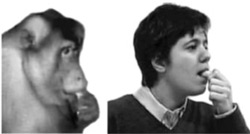 In 1992 Rizzolatti and his colleagues found a special kind of neuron in the premotor cortex of monkeys (Di Pellegrino et al., 1992).
In 1992 Rizzolatti and his colleagues found a special kind of neuron in the premotor cortex of monkeys (Di Pellegrino et al., 1992).
These neurons, which respond to perceiving an action whether it’s performed by the observed monkey or a different monkey (or person) it’s watching, are called mirror neurons
Many neuroscientists, such as V. S. Ramachandran, have seized upon mirror neurons as a potential explanatory ‘holy grail’ of human capabilities such as imitation, empathy, and language. However, to date there are no adequate models explaining exactly how such neurons would provide such amazing capabilities.
Perhaps related to the lack of any clear functional model, mirror neurons have another major problem: Their functional definition is too broad.
Typically, mirror neurons are defined as cells that respond selectively to an action both when the subject performs it and when that subject observes another performing it. A basic assumption is that any such neuron reflects a correspondence between self and other, and that such a correspondence can turn an observation into imitation (or empathy, or language).
However, there are several other reasons a neuron might respond both when an action is performed and observed.
First, there may be an abstract concept (e.g., open hand), which is involved in but not necessary for the action, the observation of the action, or any potential imitation of the action.
Next, there may be a purely sensory representation (e.g., of hands / objects opening) which becomes involved independently of action by an agent.
Finally, a neuron may respond to another subject’s action not because it is performing a mapping between self and other but because the other’s action is a cue to load up the same action plan. In this case the ‘mirror’ mapping is performed by another set of neurons, and this neuron is simply reflecting the action plan, regardless of where the idea to load that plan originated. For instance, a tasty piece of food may cause that neuron to fire because the same motor plan is loaded in anticipation of grasping it.
It is clear that mirror neurons, of the type first described by Rizzolati et al., exist (how else could imitation occur?). However, the practical definition for these neurons is too broad.
How might we improve the definition of mirror neurons? Possibly by verifying that a given cell (or population of cells) responds only while observing a given action and while carrying out that same action.
Alternatively, subtractive methods may be more effective at defining mirror neurons than response properties. For instance, removing a mirror neuron population should make imitation less accurate or impossible. Using this kind of method avoids the possibility that a neuron could respond like a mirror neuron but not actually contribute to behavior thought to depend on mirror neurons.
Of course, the best approach would involve both observing response properties and using controlled lesions. Even better would be to do this with human mirror neurons using less invasive techniques (e.g., fMRI, MEG, TMS), since we are ultimately interested in how mirror neurons contribute to higher-level behaviors most developed in homo sapiens, such as imitation, empathy, and language.
-MC
Image from The Phineas Gage Fan Club (originally from Ferrari et al. (2003)).

A recent article on mirror neurons by P. Pascolo & R. Budai says:
We discussed the method that led to enunciation by some researchers of the existence of mirror neurons, the resulting paradigm “mirror neuron system”, the existence or non existence of mirror neurons in monkeys and subsequent confirmation of the existence of similar neurons in humans. In developing this work we have been taken into account the necessity that arguments, pro and/or against, were synchronous or at least not in obvious contradiction with the observations from other disciplines: psychology, psychiatry, neurology, neurosurgery, neurophysiopathology. The survey conducted during this work has raised many doubts about the “mirror neuron system” paradigm and the consequent announcement of mirror neuron, in the meaning inferred
from the work proposed by Gallese et al. and Rizzolatti et al. in 1996, and by Rizzolatti et al. in 2001 and in 2006, because result of an experimental
protocol that was deemed inadequate. From the examination of consulted documentation one can only hypothesize that a more or less widespread network of neurons, in a subject supplied with previous experience on what he is observing, activates a function seemingly similar to “mirroring”, trying to interpret an action or what happened around, to program ad action, or to help to perform an action. Activity that manifests also in early way: in this case the virtual/imagined action, it is brought to completion before the observed action is completed. After a discussion on the consistency of the basic assumptions that have combined to define the mirror neuron, we discuss about the opportunity that the “mirror neuron system” will be replaced from time to time with paradigms closer to observation, as an example we refer to as anticipatory borrowing from posturology, the “concept neurons” and so on. The model should not cover a class of neurons, but one of several models to be used in teaching to classify some brain’s functions. This approach should allow to arrange some interpretations based on the “mirror neuron system”: imitation, the phenomenon of comparison between similar and not similar, and some Arbid’s arguments on language too biased in favor of the “mirror neuron system” as noted by Bickerton.
(From: Mirror Neurons in monkey cortical area 5: there was experimental evidence? And in human? Rivista Medica, Year XIV, Number 60 – ISNN 1127-6339)